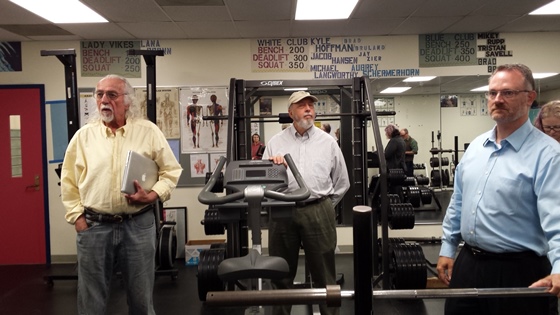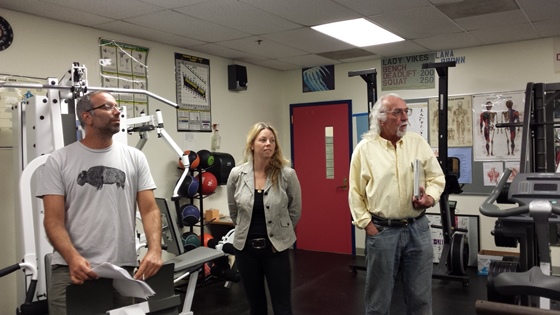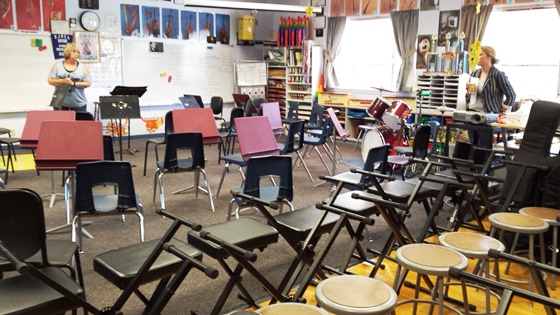— by Margie Doyle, updated Aug. 22 at 6 p.m. —

The Phase III School bond is discussed on a tour through the high school weight room with, from left, “Way Forward” Facilitator Fred Klein, Business Manager Keith Whitaker, School Superintendent Eric Webb
Should the Orcas Island School District (OISD) ask the community to support a bond for improvements? But before deciding, what improvements are we talking about?
The public was presented with a beginning draft of eight projects that might be included in such a bond, and over two days this week, islanders asked questions, offered suggestions and gave opinions on what that bond should include, and how much funding should be requested.
The School Board and Administration emphasize that these meetings were to introduce the public to the subject, and that, in the words of OISD District Board Member Janet Brownell, “Community feedback is the most important discussion for the school board.” Brownell said the board hopes to put the bond on the Feb. 2017 ballot so that construction might begin in 2018.
OISD Superintendent Eric Webb kicked off the meeting on Monday morning, encouraging the participants to “think outside the bond.”
He reviewed the bond history of the recent 10 years, including the $36 M bond failure of February 2010 and the $27M bond failure of November, 2010; as well as the $11.9M bond measure which passed in November, 2012. He acknowledged the 2011 energy grants for the elementary school and the old gym and the contributions of the Way Forward Group, which developed from the four-day consensus process instigated by Fred Klein in 2011.
Webb emphasized that there were things that were not able to get done in Phase II, which was completed in August, 2015. “We’re bringing you in to have fresh eyes,” he said, differentiating between “basic health and safety or community supported wants.”
Liz LeRoy, project manager (or “Owner’s Representative”) for Phase II, said a large part of her responsibilities is “to capture $1M in state-matched funds by making sure the paperwork gets done in a timely manner.”
She reviewed the “highlights” of Phase II (the 2012 Bond Remodeling Project, and said the purpose was two-fold: to support the students and to support current and future programs. She emphasized the importance of flexibility and creating transparency in the design of the remodeled buildings:
- The middle school which was moved into the footprint of the former libraryThe 1970s middle school building which became the library, the cafeteria, the kitchen, the culinary arts room and the computer technology classroom
- The Career and Tech Education (CTE) classroom, now built on the west side of the High School building, with garage doors for the art, applied physics and woodworking classrooms.
- The Band Room which was built on the north side of the Old Gym
- The East-West pathway connecting the High School, Middle School and Elementary School buildings
- The modular building behind the district administrative offices, now used for English Language Learning (ELL)
- The traffic circle for safe student drop-off on School Road
“We focused our energy [in Phase II[ to do it right the first time,” LeRoy said, a sentiment that was echoed by Middle/High School Principal Kyle Freeman.

Local builder Ken Katz, Project Manager Liz LeRoy and Fred Klein discuss space concerns in the high school weight room
Items that were not addressed in the 2012 Bond project were:
- Old Gym (plumbing and lighting had been updated, but not old systems);
- a music classroom on north side of band room;
- underground utilities in courtyard;
- School Road improvements
- Administration building
LeRoy then reviewed the three-page draft of projects to be considered for a new bond. The draft gave breakouts for a $5M bond and an $8M bond, which were described by Brownell as the limits that the board felt the community would support.
(On Tuesday, District Business Manager Keith Whitaker pointed out that the difference in the property tax rates necessary to repay a bond over the next 20 years between a $5M an $8M or an $8M and an $11M bond would only be about 10 cents per thousand dollars of assessed value, due to historically low interest rates. The bonds would still reward the purchasers with interest earnings two to three percent higher than standard savings accounts.)
The list, which LeRoy emphasized was her personal draft, created based on discussions with the school board and district staff, listed eight general areas for funding within a bond for Phase III. The draft list included:
- Road, fencing, playground, parking and infrastructure at a projected cost of $331,000
- Waldron School improvements, projected cost $35,000
- Administration building replacement of 1,835 square feet at a cost of $500,000; technical improvements to the existing building, costing $65,000
- Track and Field completion (District is in receipt of a $1M gift towards a track) cost at $1,000,000
- High School interiors, bathrooms water and heating, costing $295,000
- Old gym exterior replacements, improvements, locker room and bleachers upgrades, gym equipment, energy upgrades, windows, infrastructure and ccourtyard improvements, projected cost of $2,798,000
- Elementary School interiors including flooring, painting, windows, infrastructure, downspouts and mechanical, at a projected cost of $899,000
- General Needs including a new music room, furniture and flexible spaces for $1,505,000 ( or a music/theatre remodel for $680,000)
The draft projects as itemized are projected to cost a total $10,896,259 at today’s costs except for the Old Gym costs, which were determined in 2009, LeRoy said.)

The Music Room set up for the Strings Classes. Teacher Pamela Wright is on the far left, and Liz LeRoy is on the far right
LeRoy and Webb were both emphatic that the figures presented to the public on Aug. 15 and 16 were preliminary, and that some proposed projects were not priced, needing design and further investigation; while other projects listed but not priced appeared to no longer be needed.
Enrollment in programs and maintenance costs were frequently brought up over the two days of discussion of a bond for Phase III.
Webb summarized recent school enrollment as 850 “overall;” 450 for the OASIS alternative education program; and 400 “physical bodies” in the school district buildings.
Webb and LeRoy conducted tours through the campus to many of the sites identified in the Phase II bond proposal.
- Music teacher Pamela Wright showed the limits of her elementary school music classroom with the growth of the school’s String and Band programs. The music program could be expanded for choir, if scheduling would allow.
- The district administration offices showed its age and inefficiencies, with cracks between the walls and floors letting in daylight.
- The weight room off the High School gym also showed its total-capacity use. Like the new Music Room,” the weight room was in [the 2010 bond proposal] and got taken out and forgotten,” said PE teacher Cindy Elliott. “The classroom is exploding, with equipment and people.”
- On Tuesday, the public tour went out to School Road. Repaving the road outside the drop-off and the cafeteria, which is on school property; and completing a fence around school property, was estimated to cost $90,000 in the last bond calculations. The cost includes stormwater design and construction, triggered by asphalt replacement.
- The track proposal, estimated to cost $2M, was described by Brownell as a motivating project for the Phase III bond proposal. Its costs in the bond are reduced to $1M as a result of a gift from Bob Henigson’s estate to the school for $1M for a track to be used by the school in official competitions, and by the community.
It was asked if the district had considered a second M&O levy to maintain the track, Brownell responded that although there was “barely enough M&O funding to maintain the school district, it was something to look at.” As to coaching personnel for a track program, she said, “We don’t figure FTE for something that doesn’t exist.”
Superintendent Webb pointed out that “Maintenance now is less expensive, due to materials and systems.”
Brownell explained on Tuesday that the M&O levy is money “the state is supposed to pay but isn’t paying to school districts. With no state income tax, sales, property and gas taxes are [Washington state’s] primary revenue streams.”
The M&O levy paying for a dozen or so teachers in the Orcas Island School District.
Mary Poletti asked which programs have flourished and which been eliminated. In response, Webb cited the Career and Technical Education (CTE), English Language Learning (ELL), Special Education and Music programs.
County Council Member Rick Hughes said that he’s in support of the bond programs as a businessman and community councilman. “The county is at a tipping point, and will be changing in the next five years if Rock Island succeeds. People need to have a community space; we need to figure out not just [for] K-12 but also adult education, especially with the OPAL [30-unit rental housing] project coming so close.”
On Tuesday, Fred Klein, who facilitated the “Way Forward” community discussion (“a way forward to assure that the [school] facilities are adequate to meet the collective responsibility of our community’s children” in Klein’s words), which followed the rejection by voters of the $27M bond; said, “I think it’s wonderful someone has stepped up and made this significant donation; but a track and field program in the high school involves coaches and trainers and not insignificant programmatic expenses that go along with a capital facility. I’m very skeptical of it for a school district the size of Orcas Island’s.
“My concern is about the impact that this basic proposal will have on the community, on the taxpayers and I’ll just leave it at that.”
Klein was asked to forward the closing documents of that discussion to the school board and Phase III participants so that they may get a better sense of the consensus of that group.
Kyle Freeman emphasized that the track would be located on school property for use by the whole community. “While the desire to have competition envisions a [school] track team, there district doesn’t HAVE to have a track team. There’s the potential to be bigger than that. A track team is not the reason why to do it.”
District Administrative Assistant Cathy Ferran pointed out that the district has the real estate property to install the proposed track, east of the current football field on an east-west orientation. The current football field would be retained for future Little League/softball fields.
Jan Ehrlichman asked if the Orcas Park and Recreation District had been involved in talks regarding the funding of the proposed track. While conversation with Orcas rec have involved collaboration around the baseball fields, they have not considered any“financing plan discussions,” Webb said.
Catherine Pederson, President of the Music Advocacy Group and a former school music teacher, spoke of her years in Eugene, Ore. during the “golden age of track.”
“All the comment about [the bond] being so important to the community and school, and then of course I am thinking about the music room and community; it doesn’t have the pizzazz of track, but the music room is a school classroom, so I feel we have a real responsibility for a classroom that’s needed for school students.”
She recalled the words of the President of the University of Oregon celebrating the community involvement and celebration of the track program in Eugene. “Our challenge is that everybody’s got to get out and pull up their socks and create the same kind of energy, so that we could look at this all together and somehow feel responsibility for all these things.”
 Business Manager Keith Whitaker gave a presentation of the difference between bonds and levies: “A bond is a fixed term total dollar instrument. A $5M bond is sold to the buyer and the total amount is [supplied] up-front
Business Manager Keith Whitaker gave a presentation of the difference between bonds and levies: “A bond is a fixed term total dollar instrument. A $5M bond is sold to the buyer and the total amount is [supplied] up-front
“A bond levy repays the bond by the community. The 2012 bond was a 20-year bond, ans so the levy is an annual amount of money per year, calculated based on property values for that year. We have a value rich island, so for very few cents per person you generate a large amount of money.”
Whitaker said that junior taxing districts, such as the Orcas Island School District, and the Public Library, are “probably the most cost-effective mechanism for the community to get money for what it wants. It’s just a good way, and particularly right now with interest rates the way they are, based on a 3% bond rate. The cost is really minimal on an ongoing basis.”
Efforts to simplify Whitaker’s explanation led to the following tweet-sized answer:
- A bond is a loan the community has committed to – and it gets [the funding] right up front
- A levy is a promise the community will pay, through taxes
Cathy Ferran clarified that, unlike a levy, a bond needs to be passed by a supermajority vote of 60 percent.
Music teacher Pam Wright asked if a figure larger than $8M could be proposed for the Phase III bond. Janet Brownell said, “We haven’t decided anything.”
At the conclusion of Tuesday’s discussion, Brownell summarized the purpose of the bond at the end of the two-day discussions as funding for capital improvements “essential to programmatic health of the school and the community.”
The group advised school administrators to hold future outreach in the evenings, with one session providing much of the same information that was given at Monday and Tuesday’s meetings, and then a follow-up meeting with priorities reviewed.
The schedule of future meetings was announced on Sept. 13 and Sept. 21 from 5:30 to 7:30 p.m. in the school cafeteria. Childcare (with pizza) will be provided. There will be snacks and refreshments for the adults. For any questions, contact Cathy Ferran at 376-1510 or email cferran@orcas.k12.wa.us
**If you are reading theOrcasonian for free, thank your fellow islanders. If you would like to support theOrcasonian CLICK HERE to set your modestly-priced, voluntary subscription. Otherwise, no worries; we’re happy to share with you.**








One item that’s been needed for many years is a dedicated Art Room for the Elementary School (and for an Elementary Art Teacher to be hired). Perhaps there’s an existing space that could be used for this purpose, if some of the new construction already under discussion were to move forward.
The meetings are September 13 and 21, not August 13 and 21. I hope that they will be well-attended.
The need for space for the string program is quite acute, and given the minimal difference in the mil rate it would produce, the new classroom should be included in the bond levy.